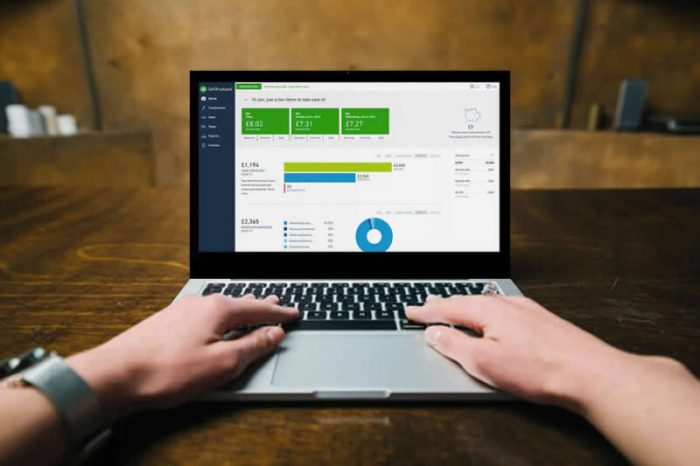Embark on a journey into the realm of QuickBooks Self-Employed Hacks for Freelancers & Creators, where financial management meets innovation and efficiency. Discover the secrets to optimizing your freelancing or creative business with these invaluable tips and tricks.
Delve deeper into the world of QuickBooks Self-Employed to unlock its full potential for streamlining your finances and maximizing productivity.
QuickBooks Self-Employed Overview
QuickBooks Self-Employed is a financial management tool designed specifically for freelancers and creators to simplify their accounting tasks. It offers various features to help users track income and expenses, organize receipts, and maximize tax deductions effectively.
Key Features of QuickBooks Self-Employed
- Income and Expense Tracking: Users can easily categorize and track their income and expenses, providing a clear overview of their financial status.
- Receipt Capture: Simply snap photos of receipts and the app will automatically categorize and organize them for easy access.
- Tax Deduction Maximization: QuickBooks Self-Employed helps users identify potential tax deductions based on their business expenses, saving them money during tax season.
Benefits of QuickBooks Self-Employed
- Time-Saving: By automating financial tasks, users can save time and focus more on their work.
- Organized Finances: The software provides a clear overview of income and expenses, helping users stay organized and make informed financial decisions.
- Tax Compliance: QuickBooks Self-Employed simplifies tax preparation and ensures users are compliant with tax regulations.
Tasks You Can Do with QuickBooks Self-Employed
- Invoice Creation: Easily create and send professional invoices to clients for faster payments.
- Bank Reconciliation: Connect your bank accounts to reconcile transactions and ensure accuracy in your financial records.
- Profit and Loss Reporting: Generate reports to analyze your business's financial performance and make informed decisions.
Setting Up QuickBooks Self-Employed
To get started with QuickBooks Self-Employed, follow these steps to set up your account, explore subscription options, and effectively link bank accounts:
Creating an Account
- Visit the QuickBooks Self-Employed website and click on the "Sign Up" or "Get Started" button.
- Enter your email address and create a password to set up your account.
- Follow the prompts to enter your personal information, business details, and income sources.
- Once your account is created, you can start exploring the features and functionalities of QuickBooks Self-Employed.
Subscription Options
- QuickBooks Self-Employed offers different subscription plans based on your needs, including the Simple Start, Essentials, and Plus plans.
- The Simple Start plan includes basic features such as tracking income and expenses, estimating quarterly taxes, and capturing receipts.
- The Essentials plan adds features like sending invoices, tracking sales tax, and managing 1099 contractors.
- The Plus plan provides additional features such as tracking time, inventory, and project profitability.
- Choose the plan that best suits your business requirements and budget.
Linking Bank Accounts and Categorizing Transactions
- Connect your bank and credit card accounts to QuickBooks Self-Employed to automatically import transactions.
- Review and categorize transactions regularly to ensure accurate financial records.
- Create custom categories to match your business expenses and income sources.
- Use the rule feature to automatically categorize transactions based on specific criteria.
- Regularly reconcile your accounts to catch any discrepancies and keep your financial data up to date.
Tracking Income and Expenses

Tracking income and expenses is crucial for freelancers as it helps in managing finances, budgeting effectively, and understanding the profitability of their work. By accurately categorizing income and expenses in QuickBooks Self-Employed, freelancers can streamline their financial tracking process and make informed decisions.
Importance of Categorizing Income and Expenses
- Helps in understanding where money is coming from and going to.
- Allows for better budgeting and financial planning.
- Enables identification of tax-deductible expenses.
- Provides insights into the profitability of different projects or clients.
Guidance on Categorizing Income and Expenses in QuickBooks Self-Employed
- Set up custom income and expense categories based on your specific business needs.
- Regularly review and update categories to ensure accurate tracking.
- Utilize the "rules" feature to automatically categorize recurring transactions.
Hacks for Automating Income and Expense Tracking
- Link your bank accounts and credit cards to QuickBooks Self-Employed for automatic transaction syncing.
- Use the mobile app to capture receipts on the go and attach them to corresponding expenses.
- Set up recurring invoices and expenses to save time on manual data entry.
- Utilize the mileage tracking feature to automatically log business-related travel expenses.
Invoicing and Payment Tracking

Creating professional invoices and tracking payments are crucial tasks for freelancers and creators to maintain a healthy cash flow. QuickBooks Self-Employed offers easy-to-use tools for invoicing and payment tracking, streamlining the process for self-employed individuals.
Creating Professional Invoices
- Start by logging into your QuickBooks Self-Employed account and selecting the option to create a new invoice.
- Fill in the necessary details such as client information, invoice due date, and a clear description of the services or products provided.
- Customize the invoice template to reflect your brand by adding your logo, colors, and personalized message.
- Review the invoice for accuracy and send it directly to your client via email through QuickBooks Self-Employed.
- Monitor the status of each invoice to track payments and follow up on any outstanding balances.
Tracking Invoice Payments and Managing Accounts Receivable
- Utilize the invoicing dashboard in QuickBooks Self-Employed to view the status of all your invoices, including those that are pending, paid, or overdue.
- Set up automatic payment reminders to notify clients of upcoming or overdue invoices, helping you stay on top of accounts receivable.
- Record payments received manually or connect your bank account to QuickBooks Self-Employed for automatic reconciliation.
- Generate reports to analyze your income and track outstanding payments, enabling you to make informed financial decisions.
Integration of Payment Gateways
- Integrate popular payment gateways such as PayPal or Stripe with QuickBooks Self-Employed to offer clients convenient and secure payment options.
- Enable online payment links on your invoices, allowing clients to pay directly through the integrated payment gateway.
- Automatically sync payment data from the integrated gateway with QuickBooks Self-Employed, reducing manual data entry and ensuring accurate financial records.
- Benefit from seamless transactions and faster payment processing by leveraging the integration of payment gateways within QuickBooks Self-Employed.
Tax Preparation and Reporting
Tax preparation and reporting can be a daunting task for freelancers and creators, but QuickBooks Self-Employed simplifies the process with its user-friendly features and tools. From tracking income and expenses to generating reports, QuickBooks Self-Employed helps you stay organized and prepared for tax season.
Maximizing Deductions
- Keep track of all business expenses, including office supplies, equipment, travel, and meals.
- Utilize the mileage tracking feature to deduct vehicle expenses for business-related trips.
- Don't forget about home office expenses, such as utilities, rent, and internet, if you work from home.
- Consider contributions to retirement accounts or health savings accounts as deductible expenses.
Minimizing Tax Liability
- Take advantage of tax credits for self-employed individuals, such as the self-employment tax deduction.
- Plan ahead and make estimated tax payments throughout the year to avoid a large tax bill at the end of the year.
- Consult with a tax professional to explore all available deductions and credits specific to your industry.
Reporting Features
- Generate profit and loss statements to get a clear picture of your business finances.
- Access detailed reports on income, expenses, and tax deductions to simplify tax filing.
- Export reports directly to your tax preparer or accountant for seamless tax preparation.
Time Tracking and Project Management
Managing your time effectively and keeping track of billable hours is crucial for freelancers and creators. QuickBooks Self-Employed offers tools to streamline this process and help you stay organized.
Time Tracking in QuickBooks Self-Employed
QuickBooks Self-Employed allows you to easily track your billable hours and link them directly to your projects or clients. This feature helps you accurately log the time spent on each task and ensures you get paid for all the work you do.
- Utilize the built-in timer to track time spent on specific projects or tasks.
- Assign billable hours to clients and projects to keep everything organized.
- Generate reports to see a breakdown of your time spent and billable hours for each client or project.
Project Management Tips
Managing projects and clients efficiently is key to running a successful freelance business. Here are some tips to help you stay on top of your workload within QuickBooks Self-Employed:
- Use project tags or categories to easily categorize and filter your projects.
- Create recurring tasks or projects for ongoing work with regular clients.
- Set reminders for important deadlines or milestones to ensure you stay on track.
Integrations with Other Tools
QuickBooks Self-Employed offers integrations with other popular project management tools to enhance your workflow and improve efficiency. By syncing your data across platforms, you can streamline your processes and eliminate manual data entry:
- Integrate with tools like Trello, Asana, or Monday.com to sync your projects and tasks seamlessly.
- Automatically import time tracking data from these tools into QuickBooks Self-Employed for accurate invoicing and reporting.
- Utilize Zapier to create custom automation workflows between QuickBooks Self-Employed and your favorite project management apps.
Customer Support and Resources
When using QuickBooks Self-Employed, it's essential to know the various customer support options available to assist you when needed. Additionally, utilizing additional resources such as tutorials, guides, and community forums can enhance your experience with the software.
Customer Support Options
- Phone Support: QuickBooks Self-Employed offers phone support to assist users with any questions or issues they may encounter while using the software.
- Live Chat: Users can also access live chat support for real-time assistance from QuickBooks experts.
- Email Support: Another option is to reach out to QuickBooks Self-Employed via email for less urgent inquiries or support.
Additional Resources
- Tutorials: QuickBooks Self-Employed provides tutorials to help users navigate the software and learn how to maximize its features for their business needs.
- Guides: In-depth guides are available to offer step-by-step instructions on various aspects of using QuickBooks Self-Employed effectively.
- Community Forums: Engaging with the QuickBooks Self-Employed community forums can provide valuable insights, tips, and best practices shared by other users.
Best Practices for Utilizing Customer Support
- Be Prepared: Before reaching out for support, gather all relevant information and details about the issue you are facing to expedite the resolution process.
- Follow Up: If you have an ongoing issue or question, make sure to follow up with customer support to ensure it gets resolved satisfactorily.
- Explore Resources: Take advantage of tutorials, guides, and community forums to proactively address common questions and learn more about using QuickBooks Self-Employed efficiently.
Ultimate Conclusion

In conclusion, the QuickBooks Self-Employed Hacks for Freelancers & Creators guide equips you with the knowledge and tools needed to take control of your financial journey. Implement these strategies to elevate your freelancing or creative endeavors to new heights of success.
Helpful Answers
How do I sign up for QuickBooks Self-Employed?
To create an account, visit the QuickBooks Self-Employed website and follow the steps to sign up with your email address and create a password.
Can QuickBooks Self-Employed help me track my expenses automatically?
Yes, QuickBooks Self-Employed has features that allow you to link your bank accounts for automatic expense tracking, saving you time and effort.
Are there any discounts available for QuickBooks Self-Employed subscriptions?
QuickBooks Self-Employed occasionally offers discounts or promotions, so it's worth keeping an eye out for any deals that may be available.
How can I integrate QuickBooks Self-Employed with other financial tools?
QuickBooks Self-Employed provides options for integrating with various financial tools to streamline your financial management processes and enhance efficiency.









